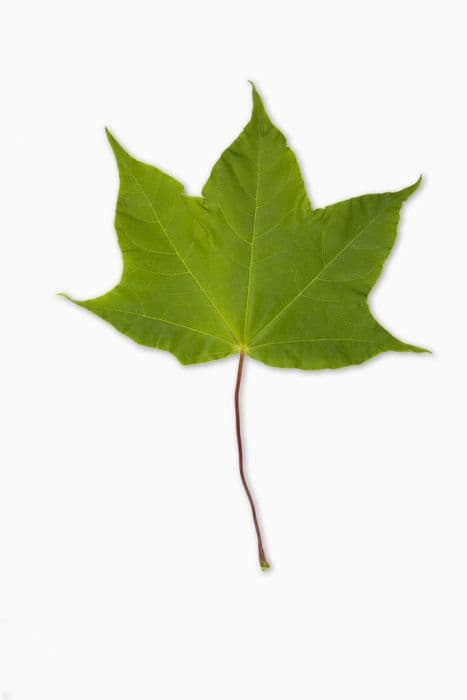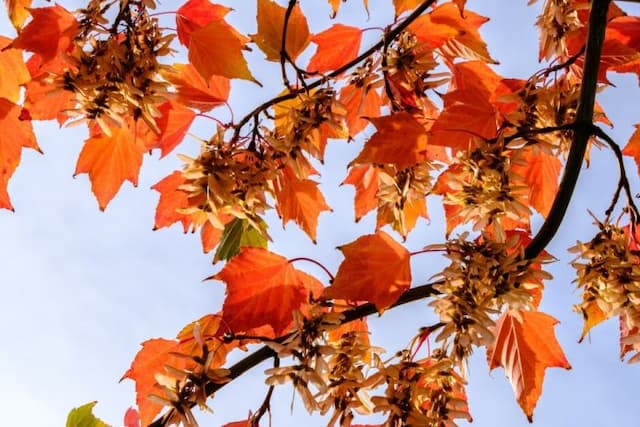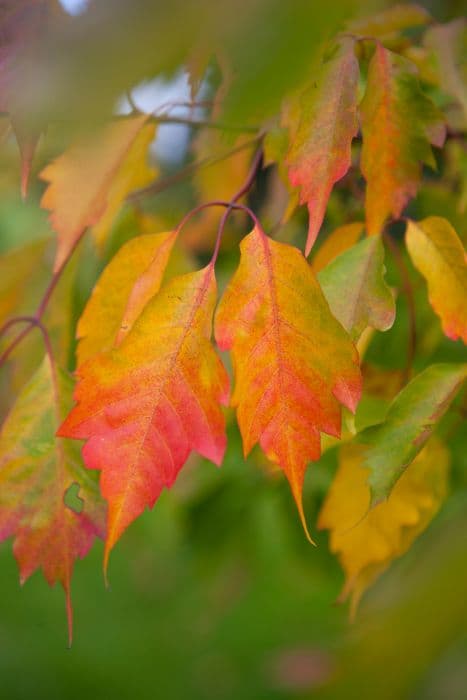Box Elder Acer negundo var. violaceum

ABOUT
The plant commonly known as box elder features a notable characteristic in its striking foliage, where the leaves exhibit a compound structure. Typically, each leaf comprises of several leaflets ranging from three to seven, or sometimes even more in some variations. The leaflets themselves are arranged oppositely, framing the leaf stalk on either side. During the spring and summer seasons, the leaves present a lush green hue, which can transition into a palette of yellows or golds as the autumn months approach. Distinctly, this particular variety of box elder sets itself apart with the unique color of its young twigs and branches, which are tinged with an alluring purple or violet shade, lending to its naming. These purple-toned branches can add aesthetic contrast and interest in a landscape, especially during the winter when the leaves have fallen. The flowers of the box elder are generally modest and less conspicuous compared to its vibrant foliage and stems. They appear in early spring, sometimes even before the leaves fully emerge. The flowers are small and may not instantly catch the eye but are nonetheless an integral part of the plant's life cycle. Following the flowering period, the plant produces its fruits, which are winged seeds, commonly known as samaras. These seeds are typically paired and can persist on the tree well into winter or until they are dispersed by the wind. The bark of the box elder is typically gray, with a textured appearance that can become deeply furrowed with age. Given its variance in appearance throughout different stages of growth and seasons, the box elder presents a dynamic and shifting display of characteristics that can be appreciated year-round.
About this plant
 Names
NamesFamily
Sapindaceae
Synonyms
Box Elder, Ash-leaved Maple, Maple Ash, Cutleaf Maple, Three-leaved Maple, Negundo Maple, Boxelder Maple, California Boxelder, Western Boxelder, Ash Maple, Manitoba Maple, Violet Box Elder
Common names
Negundo negundo var. violaceum, Acer violaceum.
 Characteristics
CharacteristicsLife cycle
Perennials
Foliage type
Deciduous
Color of leaves
Green
Flower color
Yellow-green
Height
30 feet (9 meters)
Spread
30 feet (9 meters)
Plant type
Tree
Hardiness zones
2
Native area
North America
Benefits
 General Benefits
General Benefits- Ornamental Value: Acer negundo var. violaceum, commonly known as Box Elder, adds aesthetic appeal to landscapes with its unique purple-tinted leaves and attractive form.
- Shade Provider: Box Elder trees can provide considerable shade, making them useful in parks, gardens, and urban areas to help reduce heat and create comfortable outdoor spaces.
- Erosion Control: The root system of the Box Elder can help to stabilize soil and control erosion, particularly on slopes or areas prone to soil degradation.
- Wildlife Habitat: The Box Elder tree provides habitat and food for wildlife, including birds and small mammals who feed on its seeds.
- Adaptability: Box Elder is known for its ability to thrive in a wide range of soil types and environmental conditions, making it a resilient and low-maintenance choice for many landscapes.
- Fast Growth: As a fast-growing species, Box Elder can quickly provide the benefits of a mature tree in a relatively short period of time.
- Windbreak: When planted in rows or groups, Box Elder can act as a windbreak, offering protection against strong winds and storms for homes and croplands.
 Medical Properties
Medical Properties- Anti-inflammatory: The leaves have been used in traditional medicine for their potential anti-inflammatory properties.
- Pain relief: There is a historical usage of the plant for alleviating pain, particularly related to wounds or bruises.
- Wound healing: The bark and leaves may have been used in poultices to promote the healing of wounds.
- Fever reduction: Infusions of parts of the plant were sometimes used to help reduce fevers.
- Antirheumatic: It has been used in the past to treat rheumatic pain.
 Air-purifying Qualities
Air-purifying QualitiesThis plant is not specifically known for air purifying qualities.
 Other Uses
Other Uses- Woodworking: The wood of the Boxelder is soft and easy to work with, making it a suitable material for small wooden items like bowls, crates, and pallets.
- Landscape Dye: The foliage and twigs can be used to create a natural dye for fabrics or paper, producing soft earth tones.
- Water Indicator: Since Boxelder typically grows near water sources, it can be used by wilderness enthusiasts as an indicator of groundwater or streams nearby.
- Maple Syrup: Although not as commonly tapped as other maples, the Boxelder can be used to produce maple syrup with a unique flavor profile.
- Soil Improvement: Boxelder trees, as part of agroforestry practices, can contribute to soil enrichment through nitrogen fixation and leaf litter decomposition.
- Spiritual Symbolism: In some cultures, the Boxelder may be considered a spiritual tree and is used in various ceremonial and symbolical practices.
- Environmental Education: The tree can be used as a teaching tool for lessons on botany, ecology, and the importance of native tree species within their ecosystems.
- Frosted Panes: The leaves, when pressed and dried, can be used to create decorative frosted window panes or art by arranging them between two glass panels.
- Beekeeping: Boxelder flowers provide an early source of pollen and nectar for bees, making it a beneficial tree to plant near apiaries.
- Photographic Backdrops: The distinctive purple-tinted new growth can be used as a vivid and unusual backdrop for outdoor photography.
Interesting Facts
 Feng Shui
Feng ShuiThe Box Elder is not used in Feng Shui practice.
 Zodiac Sign Compitability
Zodiac Sign CompitabilityThe Box Elder is not used in astrology practice.
 Plant Symbolism
Plant Symbolism- Resilience: The Boxelder is known for its ability to endure and adapt, often growing in difficult conditions where other trees may fail.
- Growth: As a fast-growing species, the Boxelder symbolizes quick and expansive growth, both physically and metaphorically.
- Adaptability: Given its capacity to thrive in varied environments, this tree is often associated with flexibility and the ability to adjust to changing circumstances.
- Balance: The dichotomy of its delicate foliage against a sturdy trunk represents balancing contrasting elements in life.
- Protection: The wood of Boxelder has been used by various cultures for various purposes, thereby symbolizing shelter and protection.
 Water
WaterThe Boxelder Maple, commonly known as Acer negundo var. violaceum, prefers consistently moist soil and should be watered deeply about once a week. During hot and dry periods, the frequency may increase to twice a week. Provide the tree with approximately 15-20 gallons of water per watering session to ensure it reaches the root zone. It's important to avoid waterlogging, so allow the soil to dry out slightly between waterings. During the winter months, reduce the frequency of watering as the tree's water requirements decrease.
 Light
LightThe Boxelder Maple thrives in full sun to partial shade. This means the ideal spot for planting this variety of maple is where it can receive at least 4-6 hours of direct sunlight daily but is also afforded some protection during the hottest part of the day. An area with dappled sunlight or where it can enjoy the morning sun and is shaded in the afternoon is also suitable.
 Temperature
TemperatureThe Boxelder Maple is hardy and adaptable, preferring a temperate climate. It can withstand a minimum temperature of around -40°F and can survive up to a maximum of about 90°F. The ideal temperature range for this maple is between 60°F and 85°F, which promotes healthy growth. Extreme temperatures both low and high may affect the tree's health, so it's best situated in locations that typically stay within this range.
 Pruning
PruningPruning the Boxelder Maple should be done to remove dead or damaged limbs, maintain shape, and encourage healthy growth. The best time to prune is during the dormant season, in late winter or early spring, before the sap starts to flow. Prune sparingly, as excessive cutting can harm the tree. Remove no more than 25% of the canopy in a single year and always cut back to a healthy branch or bud.
 Cleaning
CleaningAs needed
 Soil
SoilBoxelder Maple thrives best in a well-draining soil mix with a pH range of 6.0 to 7.5. A mixture of loam, sand, and peat moss is ideal, allowing for adequate moisture retention while still providing good drainage to prevent root rot.
 Repotting
RepottingBoxelder Maples, particularly when young, should be repotted every 2 to 3 years to encourage growth. Mature trees will slow down in growth and can be repotted less frequently, about every 3 to 5 years, or when the root system outgrows the pot.
 Humidity & Misting
Humidity & MistingThe Boxelder Maple is adaptable and does not require any special humidity conditions. It fares well in average outdoor humidity levels and does not demand a high moisture environment.
 Suitable locations
Suitable locationsIndoor
Place Boxelder Maple in bright, indirect sunlight indoors.
Outdoor
Choose a spot with full sun to part shade for Boxelder Maple.
Hardiness zone
2-10 USDA
 Life cycle
Life cycleAcer negundo var. violaceum, commonly known as Boxelder Maple or Violet Boxelder, begins its life cycle when mature trees produce wind-pollinated flowers in early spring, prior to leaf emergence. After pollination, the flowers develop into paired, winged samaras that are typically dispersed by wind in the fall. Once the samaras land in a suitable location, they germinate in the following spring under appropriate conditions of moisture and temperature, giving rise to seedlings. The seedlings develop an extensive root system and a shoot that grows rapidly, provided they have sufficient light, nutrients, and water. As a fast-growing but relatively short-lived tree, the Boxelder reaches maturity in as few as 10 years, where it starts flowering and producing samaras to continue the reproductive cycle. Throughout its lifespan, which can range from 30 to 60 years, the tree undergoes recurring annual growth cycles, including a dormant phase during winter and a growth phase through spring and summer.
 Propogation
PropogationPropogation time
Spring to early summer
The Box Elder Maple (Acer negundo var. violaceum), like many other maples, is most commonly propagated by seed. The best time to collect seeds is in the fall when they mature, usually around October. Once collected, the seeds can undergo stratification, a process which involves simulating winter conditions to break the seed dormancy. This stratification typically involves mixing the seeds with moist sand and refrigerating them at around 34-41 degrees Fahrenheit (1-5 degrees Celsius) for around 90-120 days. After stratification, the seeds can be sown in pots or seedbeds in the spring. They should be placed at a shallow depth, covered with only a light sprinkling of soil, and kept moist until germination occurs. It's important to protect the young seedlings from extreme conditions until they're strong enough to be planted out.









